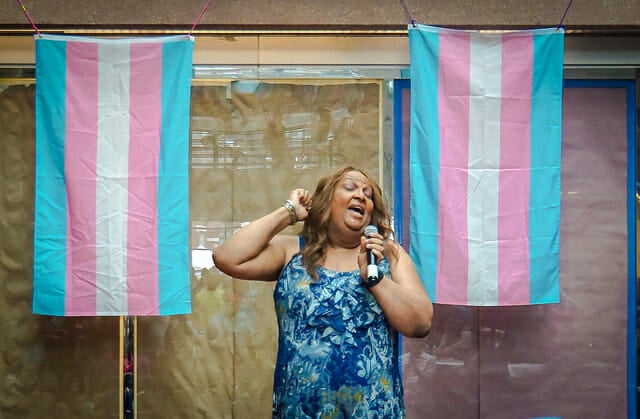As transgender rights are being threatened and fought for across the country, trans celebrities and LGBTQ activists are challenging the rest of us to see sex and gender identity as two entities.
But what is gender identity exactly, and how does it differ from the sex a person is assigned at birth? Why aren’t these terms interchangeable? What does it mean to be male, and what does it mean to be female? Turns out, there’s a pretty straightforward answer behind an often complicated subject.
The difference between sex and gender identity
What is sex assigned at birth?

In many cases, when a baby is born, a delivery doctor or midwife assigns a sex to the child: male or female. This assigned sex is based on the physical characteristics that define a person’s body: their genitals, their hormones, and their secondary sex characteristics (such as breasts), to name a few. This is then marked on a birth certificate for the government’s records.
More often than not, sex assignment is conflated with one’s gender identity. But gender and sex are two completely different things. While sex is defined by the physical characteristics observed on the human body, gender is a psychological experience. And how a person identifies gender-wise doesn’t always fit neatly into the binary categories of male and female.
“Some people call the sex we’re assigned at birth ‘biological sex.’ But this term doesn’t fully capture the complex biological, anatomical, and chromosomal variations that can occur,” Planned Parenthood explains. “Having only two options (biological male or biological female) might not describe what’s going on inside a person’s body.”
What is gender identity?

The gender-inclusive advocacy organization Gender Spectrum calls gender identity “our deeply held, internal sense of self as male, female, a blend of both, or neither.” In other words, our gender is “who we internally know ourselves to be.”
From there, gender expression is “how we present our gender in the world and how society, culture, community, and family perceive, interact with, and try to shape our gender.” This happens in relation to gender roles—how one should dress, act, behave—based on one’s perceived gender identity.
READ MORE:
- The dirty, complex, empowering history of the word ‘queer’
- How big is the transgender population, really?
- The financial costs of an uninsured abortion
Gender identity is linked closely with a person’s perception of their body, as an individual may change their physical appearance to match (or maintain) their gender. For example, you are cisgender if your gender identity corresponds with the sex you were assigned at birth.
Transgender men and women can take hormone replacement therapy to change their body’s physical functioning. Cisgender men with removed testicles may take testosterone injections to maintain their testosterone levels, and women with Kallmann syndrome may take estrogen to begin puberty. While each of these situations may change or maintain a person’s physical appearance, their gender identity remains intact regardless of how their body looks.
We become aware of our gender identity over time

No one is born fully understanding their gender identity. Gender, as a concept, is socialized through exposure to people and gender roles—and scientists are still unsure when young children begin to grasp the concept of gender identity.
According to one 2010 study, most children have a working knowledge of gender roles by 18 to 24 months, including a sense of awareness regarding one’s own gender. For a child to develop “a stable sense of their gender identity” it can take up to four years, says the American Academy of Pediatrics.
Not everyone understands their gender at a young age, though. Many transgender people spend their childhood and young adult lives unsure of their gender identity. This is because trans people are often bombarded from an early age with messages that equate sex with gender. As a result, some trans people need decades to understand their gender identity and begin transitioning. Others figure it out relatively young but still struggle with acceptance or support from their families.
Either way, gender is difficult to understand because our society sends so many mixed signals about sex, gender roles, and gender expression.
The good news is that most children see gender as extremely flexible. The Conversation cites one research study where 3- to 5-year-olds were shown a photo of two toddlers cross-dressing: a cisgender boy in girls’ clothes and a cisgender girl in boys’ clothes. Respondents thought the cisgender boy was a girl and vice versa. The study suggests that young children view gender as relatively fluid and that more rigid definitions of gender (such as those that fuel transphobia) are learned over time, and thus socialized concepts that can be altered or change.
Scientists are still figuring out gender’s causes
There are various theories in the scientific community regarding gender identity’s origins. One study from the Scientific American reveals that transgender people’s brains function similarly to their cisgender counterparts. This suggests that one’s gender identity, not their sex assigned at birth, defines how the brain operates and functions.
Gender itself may be created in the womb, too. As Jane Brody writes for the Sarasota Herald-Tribune, recent reports reveal that a change in the brain’s sexual differentiation during pregnancy may lead to a fetus developing a gender identity that differs from cisgender gender development. Transgender women’s brains, for example, may develop as women while the body develops a penis and scrotum. Meanwhile, excess androgens could cause transgender men to develop their gender identity as men while their body continues to develop a vagina and ovaries.
While scientists are still researching the causes behind gender dysphoria (the feeling that your gender does not match your sex assigned at birth), transgender experiences can help paint a wider picture of human gender identity by explaining how gender emerges, how it exists separately from sex, and why there are so many people who do not identify with the gender they were assigned at birth.
READ MORE:
- 8 out and open transgender celebrities you should know about
- Sapiosexuality is rising—but what is it exactly?
- The pride and pitfalls in LGBTQ labels
Our understanding of sex is changing fundamentally
As trans activist and vlogger Riley Dennis explains, referring to a trans woman as a woman who is “biologically male” can be harmful.
“I would argue that sex needs to go through the same change that gender has already gone through,” Dennis says. “It’s not a static fact. It’s a social construct.”
In other words, there are better terms to use when talking about bodies rather than “male” and “female.”
Trans and intersex activists consider our current male/female sex binary a “simplification” of nature, ignoring the fact that sex and gender cannot be aligned so neatly based on two simple categories. Instead, these advocates believe that sex is a social construct, based on social and cultural ideas of how a body should look—and how it should be gendered.
This is particularly clear when it comes to intersex bodies. According to the Intersex Society of North America, intersex is a term used to describe people “born with a reproductive or sexual anatomy that doesn’t seem to fit the typical definitions of female or male.” For instance, some intersex people are born with a large clitoris, a scrotum formed like a labia, or a mixture of XX and XY chromosomes.
Sometimes intersex conditions appear at an early age; other times, they emerge during puberty. But regardless, intersex experiences suggest that bodies cannot be rigidly defined into “male” and “female” categories. Every person’s body is different.
Sex isn’t inherently gendered
“Sex isn’t something we’re actually born with, it’s something that doctors or our parents assign us at birth,” Mey Rude writes for Autostraddle. “Neither chromosomes nor genitals are binary in the way that ‘biological sex’ defenders claim they are, and the vast majority of measures by which we judge sex are very much changeable.”
Instead, Rude suggests that sex isn’t inherently gendered. From an objective perspective, sex is simply a series of biological reactions that cause certain characteristics (such as facial hair or muscle mass) to appear or disappear within a person’s body. And because our definitions of sex are arbitrary and inconsistent, that also means someone can change sexes by altering their hormone levels and genitalia.
“There’s nothing intrinsically male about XY chromosomes, testosterone, body hair, muscle mass or penises,” Rude explains. “Sex, like gender, is indeed socially constructed and can be changed.”
So while gender itself is a real experience that people psychologically experience, sex is largely defined by social and cultural values, and not necessarily by objective scientific reality.
So, what is the new gender paradigm?

Trans acceptance is still an uphill battle. Even among trans-inclusive communities, many still see cisgender gender identities as humanity’s default gender identities. Most people do not want to admit that sex is socially defined, gender roles are artificial, and our sense of self is a more important defining factor than a doctor peeking at a baby’s private parts.
But as trans activists introduce a more neutral look at human biology, young Americans are challenging the way they think about gender and sex. It may take some time, and not everyone will understand right away, but asking questions about sex and gender identity is the first step to a much larger conversation on accepting trans, intersex, and gender nonconforming peoples’ identities as valid.
“People need to start learning about what sex really is and what social constructs really are,” Rude writes. “[They] need to stop misusing biology and spreading ignorance and misunderstanding. People need to stop looking for excuses for their anti-trans bigotry. All of this needs to stop and it needs to stop now.”
Editor’s note: This article is regularly updated for relevance.




